 W
WAgriocnemis femina, the variable wisp or pinhead wisp, is a species of damselfly in the family Coenagrionidae. It is a small damselfly; mature males have a white pruinescence over their body, and a dark tail. It is found from India, through South-east Asia to islands in the Pacific. where it inhabits pools and stagnant water.
 W
WThe Argentine ant, formerly Iridomyrmex humilis, is an ant native to northern Argentina, Uruguay, Paraguay, Bolivia and southern Brazil. It is an invasive species that has been established in many Mediterranean climate areas, inadvertently introduced by humans to many places, including South Africa, New Zealand, Japan, Easter Island, Australia, Europe, Hawaii, and the continental United States.
 W
WAtacta brasiliensis is a species of bristle fly in the family Tachinidae. It is found in North America.
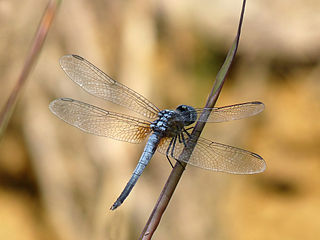 W
WBrachydiplax chalybea is a species of dragonfly in the family Libellulidae. It is known by the common names yellow-patched lieutenant, rufous-backed marsh hawk, and blue dasher. It is native to much of eastern Asia, from India to Japan to Indonesia.
 W
WBrachymyrmex patagonicus is a species of ant in the family Formicidae.
 W
WCephalotes quadratus is a species of arboreal ant of the genus Cephalotes, characterized by an odd shaped head, and the ability to "parachute" by steering their fall if they drop off of the tree they're on. Giving their name also as gliding ants.
 W
WColletes compactus is a species of ground-nesting bee in the genus Colletes.
 W
WColletes validus, colloquially known as the blueberry cellophane bee or blueberry polyester bee, is a solitary, specialist bee in the family Colletidae. It is found primarily in eastern North America where it nests in sandy soils near ericaceous plants.
 W
WCrocothemis nigrifrons is a species of dragonfly in the family Libellulidae. Its common names include black-headed skimmer and blue-scarlet dragonfly. It is found in Australia, Papua New Guinea, and the Solomon Islands.
 W
WDrymaplaneta semivitta is a species of cockroach native to Australia and introduced to New Zealand. In New Zealand, it is known as the Gisborne cockroach, after the city of Gisborne where it was first discovered in the country.
 W
WEchthrus niger is a species of ichneumon wasp in the family Ichneumonidae.
 W
WEupolyphaga sinensis, is a species of wingless, flightless cockroach in the genus Eupolyphaga, native to Western China and Mongolia. The dried body is used in traditional Chinese medicine.
 W
WThe Florida woods cockroach or palmetto bug is a large cockroach species which typically grows to a length of 30–40 mm (1.2–1.6 in). When alarmed, adults can eject an extremely foul-smelling directional spray up to 1 m, which inspired several of its other common names: Florida skunk roach, Florida stinkroach, skunk cockroach, skunk roach, stinking cockroach, and stinkroach. Two other naming variations include Florida cockroach and Florida woods roach.
 W
WGynacantha mexicana, the bar-sided darner, is a species of darner in the dragonfly family Aeshnidae. It is found in Central America, North America, and South America.
 W
WHoplisoides tricolor is a species of sand wasp in the family Crabronidae. It is found in Central America and North America.
 W
WMegachile fumipennis is a species of bee in the family Megachilidae. It was described by Smith in 1868.
 W
WMegachile sexmaculata is a species of bee in the family Megachilidae. It was described by Smith in 1868.
 W
WMydas ventralis is a species of mydas flies in the family Mydidae.
 W
WNannodiplax rubra, commonly called the pygmy percher, is a species of dragonfly in the monotypic genus Nannodiplax. Its distribution seems to be limited to Australia and New Guinea. They are tiny dragonflies with a bright red abdomen and clear wings. They are found near a wide variety of rivers and streams. The Australian distribution ranges from Broome, Western Australia via the north and east to around Coffs Harbour, New South Wales. The taxon has not yet been assessed for the IUCN Red List, but it is listed in the Catalogue of Life.
 W
WThe neon skimmer is a dragonfly of the skimmer family. It can be found near ponds, lakes and slow moving streams in the southwest United States, Central America, and northern South America.
 W
WNomada bethunei, the cuckoo bee, is a species of nomad bee in the family Apidae. It is found in North America.
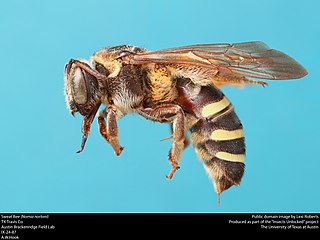 W
WNomia nortoni, known as the Norton's nomium or Norton's alkali bee, is a species of sweat bee in the family Halictidae. It is found in Central America and North America.
 W
WNylanderia pygmaea is an extinct species of formicid in the ant subfamily Formicinae known from fossils found in the Baltic region.
 W
WThe Marsh skimmer, also known as tricolored marsh hawk, and slender blue skimmer, is a species of dragonfly in the family Libellulidae. It is widespread in many Asian countries.
 W
WOrthetrum villosovittatum, known as the fiery skimmer, is a species of dragonfly in the family Libellulidae. Its range is from the Moluccas, New Guinea and neighbouring islands as well as Australia. In Australia it is found in Victoria through eastern New South Wales and Queensland, north inland Queensland, Cape York Peninsula and north Northern Territory. It is a common species through most of its range.
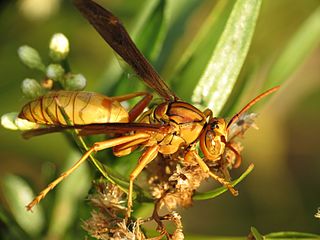 W
WPolistes flavus is a species of paper wasp in the family Vespidae.
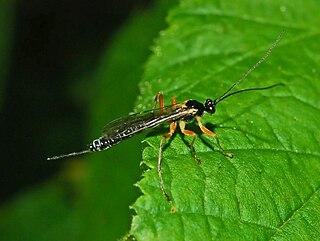 W
WPolysphincta boops is a species belonging to the family Ichneumonidae subfamily Pimplinae.
 W
WPristaulacus stigmaticus is a species of wasp in the family Aulacidae. It is found in Southern Asia.
 W
WSigara scotti is a species of water boatman in the family Corixidae in the order Hemiptera.
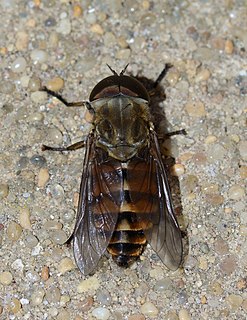 W
WTabanus eggeri is a Mediterranean species of biting horse-fly, found in southern France, Italy, Albania, Croatia, Herzegovina, Bulgaria, Portugal and Morocco. There are also unverified accounts of sightings in Spain and Israel.
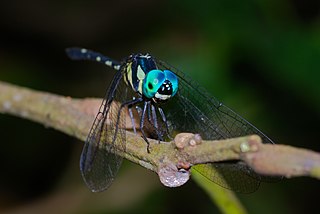 W
WTetrathemis irregularis is a species of dragonfly in the family Libellulidae, known as the rainforest elf. It is a tiny to small, slender dragonfly with black and yellow markings. It inhabits rainforest streams in north-eastern Australia and Southeast Asia, including the Aru Islands.
 W
WThe Turkestan cockroach, also known as the rusty red cockroach, red runner cockroach or simply rusty red, red runner, or lat, is a primarily outdoor-dwelling cockroach native to an area from northern Africa to Central Asia. Adults measure around 3 cm (1.2 in) in length. Adult males are a brownish orange or red, are slender, and have long, yellowish wings which allow it to attract females and to glide. Adult females are dark brown to black, with cream-colored markings on the shield and a cream-colored stripe edging its wings; they are broader than males, and have short vestigial wings. Nymphs are brown in front, black on the rear, and are wingless.
 W
WVespa simillima, the yellow hornet, including the color form known as the Japanese hornet or Japanese yellow hornet (キイロスズメバチ), is a common hornet species in the Eastern Hemisphere. The typical mainland color form is darker and hairier than the yellow form; it lives in Hokkaido, the Korean Peninsula, Eastern Siberia and China, but is less common in Japan, where the yellow color form predominates. It should not be confused with the Asian giant hornet, which has a color form sometimes referred to as the "Japanese giant hornet". While there is a history of recognizing subspecies within many of the Vespa hornets, the most recent taxonomic revision of the genus treats all subspecific names in the genus Vespa as synonyms, effectively relegating them to no more than informal names for regional color forms.